Energy Flexibility Realization in Grid-Interactive Buildings for Demand Response: State-of-the-Art Review on Strategies, Resources, Control, and KPIs
Abstract
1. Introduction
2. Building Energy Flexibility
2.1. Strategies for Building Energy Flexibility
- (1)
- Load covering: As shown in Figure 3a, the power generation from on-site distributed renewable energy (e.g., PV and wind turbine) is used to cover a portion or the entirety of building energy demand during peak hours. Thereby, the primary objective of this strategy is to curtail peak power demand on the grid and enhance the grid reliability, which persists for a duration of 2 to 4 h during the peak period.
- (2)
- Load shifting: This strategy refers to the use of flexible resources such as energy storage and shiftable loads to achieve peak shaving and valley filling of the load profile of buildings, as shown in Figure 3b. The implementation of this strategy is commonly guided by electricity price signals or incentive mechanisms, which realizes 4 to 6 h of power mitigation.
- (3)
- Load shedding: This strategy refers to rapidly cutting off the load in response to the emergency regulation demands of the grid, thereby leading to a swift reduction in the power consumption of buildings. Its duration usually only lasts a few minutes or seconds, which can help the power system recover from emergencies. In recent applications, this strategy has also been employed as a virtual energy storage capacity by the integration of an intermittent run of HVAC system and building thermal inertia.
2.2. The Flexible Resources of Buildings
2.2.1. Distributed Renewable Energy
2.2.2. Energy Storage Systems
2.2.3. Shiftable Loads and Interruptible Loads
3. Control Methodologies for Building Energy Flexibility
3.1. Rule-Based PID Control
3.2. Model-Based Predictive Control
3.3. Multi-Scale Model-Based Predictive Control
3.4. Adaptive Model-Based Predictive Control
3.5. Data-Driven Predictive Control
3.6. Agent-Based Control
4. Evaluation Indicators and Methodology
5. Discussion
6. Conclusions
Author Contributions
Funding
Data Availability Statement
Conflicts of Interest
References
- IPCC. Climate Change 2023: Synthesis Report. Contribution of Working Groups I, II and III to the Sixth Assessment Report of the Intergovernmental Panel on Climate Change. 2023. Available online: https://www.ipcc.ch/report/ar6/syr/ (accessed on 11 June 2025).
- Liu, K.; Tian, J.; Chen, J.; Wen, Y. Low-Carbon Retrofitting Path of Existing Public Buildings: A Comparative Study Based on Green Building Rating Systems. Energies 2022, 15, 8724. [Google Scholar] [CrossRef]
- International Energy Agency. Net Zero by 2050: A Roadmap for the Global Energy Sector. 2022. Available online: https://www.iea.org/reports/net-zero-by-2050 (accessed on 11 June 2025).
- Yu, Z.Y.; Lu, F.; Zou, Y. Quantifying the flexibility of lighting systems by optimal control in commercial buildings: Insight from a case study. Energy Build. 2020, 225, 110310. [Google Scholar] [CrossRef]
- Ekechukwu, D.; Simpa, P. A comprehensive review of renewable energy integration for climate resilience. Eng. Sci. Technol. J. 2024, 5, 1884–1908. [Google Scholar] [CrossRef]
- Villar, J.; Bessa, R. Flexibility products and markets: Literature review. Electr. Power Syst. Res. 2018, 154, 329–340. [Google Scholar] [CrossRef]
- Bayasgalan, A.; Park, Y.S.; Koh, S.B. Comprehensive Review of Building Energy Management Models: Grid-Interactive Efficient Building Perspective. Energies 2024, 17, 4794. [Google Scholar] [CrossRef]
- Han, J.; Choi, C.S.; Park, W.K. Smart home energy management system including renewable energy based on ZigBee and PLC. IEEE Trans. Consum. Electron. 2014, 60, 198–202. [Google Scholar] [CrossRef]
- Robichaud, L.B.; Anantatmula, V.S. Greening Project Management Practices for Sustainable Construction. J. Manag. Eng. 2010, 27, 48–57. [Google Scholar] [CrossRef]
- Panto, M.; Lukas, L. Enhancing power system reliability through demand flexibility of Grid-Interactive Efficient Buildings: A thermal model-based optimization approach. Appl. Energy 2025, 381, 125045. [Google Scholar] [CrossRef]
- Yue, L.; Niu, J.; Tian, Z. A three-dimensional evaluation method for building energy systems to guide power grid-friendly interactions during the planning and operational stages. J. Build. Eng. 2024, 86, 108816. [Google Scholar] [CrossRef]
- Lv, Q. Intelligent building design based on green and low-carbon concept. Energy Inform. 2025, 8, 55. [Google Scholar] [CrossRef]
- Habiba, U.E.; Ahmed, I.; Asif, M. A review on enhancing energy efficiency and adaptability through system integration for smart buildings. J. Build. Eng. 2024, 89, 109354. [Google Scholar] [CrossRef]
- Wang, D.; Almojil, S.F.; Ahmed, A.N. An intelligent design and environmental consideration of a green-building system utilizing biomass and solar having a bidirectional interaction with the grid to achieve a sustainable future. Sustain. Energy Technol. Assess. 2023, 57, 103287. [Google Scholar] [CrossRef]
- Hainoun, A.; Stortecky, S.; Horak, D. Monitoring and evaluation of integrated energy solutions in a Zero-Energy building (ZEB) in Vienna. Energy Build. 2025, 343, 115906. [Google Scholar] [CrossRef]
- Li, H.; Wang, Z.; Hong, T. Energy Flexibility of Residential Buildings: A Systematic Review of Characterization and Quantification Methods and Applications. Adv. Appl. Energy 2021, 3, 100054. [Google Scholar] [CrossRef]
- Luc, K.M.; Heller, A.; Rode, C. Energy demand flexibility in buildings and district heating systems—A literature review. Adv. Build. Energy Res. 2019, 13, 241–263. [Google Scholar] [CrossRef]
- Liu, J.; Chen, X.; Yang, H. Energy storage and management system design optimization for a photovoltaic integrated low-energy building. Energy 2020, 190, 116424. [Google Scholar] [CrossRef]
- Kang, X.; Wang, X.; Liu, Z. Capacity optimization and carbon-effective assessment of building micro-grids integrating PV, EV, and energy storages. Sustain. Cities Soc. 2025, 130, 106566. [Google Scholar] [CrossRef]
- Liu, Y.; Feng, G.; Chang, S. Research on the design and hierarchical control strategy of wind-PV-energy storage and electric vehicle integrated energy systems for zero-carbon buildings. Energy Build. 2025, 345, 116032. [Google Scholar] [CrossRef]
- Robledo, C.B.; Oldenbroek, V.; Abbruzzese, F. Integrating a hydrogen fuel cell electric vehicle with vehicle-to-grid technology, photovoltaic power and a residential building. Appl. Energy 2018, 215, 615–629. [Google Scholar] [CrossRef]
- Fan, P.; Wang, D.; Wang, W. A novel multi-energy load forecasting method based on building flexibility feature recognition technology and multi-task learning model integrating LSTM. Energy 2024, 308, 132976. [Google Scholar] [CrossRef]
- Yang, Y.; Duan, Q.; Samadi, F. A systematic review of building energy performance forecasting approaches. Renew. Sustain. Energy Rev. 2025, 223, 116061. [Google Scholar] [CrossRef]
- Afroz, Z.; Wu, H.; Sethuvenkatraman, S. A study on price responsive energy flexibility of an office building under cooling dominated climatic conditions. Energy Build. 2024, 316, 114359. [Google Scholar] [CrossRef]
- Qiang, W.; Liao, Y.; Deng, J. Research on systematic analysis and optimization method for ice storage cooling system based on model predictive control: A case study. Energy Build. 2025, 326, 115065. [Google Scholar] [CrossRef]
- Liu, J.; Yang, X.; Liu, Z. Investigation and evaluation of building energy flexibility with energy storage system in hot summer and cold winter zones. J. Energy Storage 2022, 46, 103877. [Google Scholar] [CrossRef]
- Wei, Y.; Meng, Q.; Zhao, F. Direct load control-based optimal scheduling strategy for demand response of air-conditioning systems in rural building complex. Build. Environ. 2024, 258, 111584. [Google Scholar] [CrossRef]
- Jin, X.; Zheng, S.; Huang, G. Energy and economic performance of the heat pump integrated with latent heat thermal energy storage for peak demand shifting. Appl. Therm. Eng. 2023, 218, 119337. [Google Scholar] [CrossRef]
- Muntean, D.; Tokar, A.; Dorca, A. Expanding the prosumer concept to enhance the efficiency of district heating systems. A case study. Rev. Română Ing. Civ. 2024, 15, 167–174. [Google Scholar] [CrossRef]
- Symeonidou, M.M.; Zioga, C.; Papadopoulos, A.M. Life cycle cost optimization analysis of battery storage system for residential photovoltaic panels. J. Clean. Prod. 2021, 309, 127234. [Google Scholar] [CrossRef]
- Das, B.K.; Hassan, R.; Islam, M.S. Influence of energy management strategies and storage devices on the techno-enviro-economic optimization of hybrid energy systems: A case study in Western Australia. J. Energy Storage 2022, 51, 104239. [Google Scholar] [CrossRef]
- Bowoto, O.K.; Emenuvwe, O.P.; Azadani, M.N. Gravitricity based on solar and gravity energy storage for residential applications. Int. J. Energy Environ. Eng. 2021, 12, 503–516. [Google Scholar] [CrossRef]
- D’hulst, R.; Labeeuw, W.; Beusen, B. Demand response flexibility and flexibility potential of residential smart appliances: Experiences from large pilot test in Belgium. Appl. Energy 2015, 155, 79–90. [Google Scholar] [CrossRef]
- Ning, L.; Liang, K.; Zhang, B. A two-layer optimal scheduling method for multi-energy virtual power plant with source-load synergy. Energy Rep. 2023, 10, 4751–4760. [Google Scholar] [CrossRef]
- Liu, J.; Pan, Z.; Wu, H. Energy optimization of building-integrated photovoltaic for load shifting and grid robustness in high-rise buildings based on optimum planned grid output. Energy Convers. Manag. 2025, 324, 119320. [Google Scholar] [CrossRef]
- Yan, Q.; Wang, J.; Lin, T. Peak-Valley difference based pricing strategy and optimization for PV-storage electric vehicle charging stations through aggregators. Int. J. Electr. Power Energy Syst. 2025, 169, 110812. [Google Scholar] [CrossRef]
- Tifoura, K.; Meliani, H.; Mahrane, A. Home energy management system based on applied real-time load scheduling for self-consumption enhancement. Energy Build. 2025, 345, 116107. [Google Scholar] [CrossRef]
- Yang, H.; Zhang, S.; Zeng, J. Future of sustainable renewable-based energy systems in smart city industry, Interruptible load scheduling perspective. Sol. Energy 2023, 263, 111866. [Google Scholar] [CrossRef]
- Duan, J.; Tian, Q.; Liu, F. Optimal scheduling strategy with integrated demand response based on stepped incentive mechanism for integrated electricity-gas energy system. Energy 2024, 313, 133689. [Google Scholar] [CrossRef]
- Chojecki, A.; Ambroziak, A.; Borkowski, P. Fuzzy Controllers Instead of Classical PIDs in HVAC Equipment: Dusting Off a Well-Known Technology and Today’s Implementation for Better Energy Efficiency and User Comfort. Energies 2023, 16, 2967. [Google Scholar] [CrossRef]
- Parvin, K.; Lipu, M.; Hannan, M.A. Intelligent Controllers and Optimization Algorithms for Building Energy Management Towards Achieving Sustainable Development: Challenges and Prospects. IEEE Access 2021, 9, 41577–41602. [Google Scholar] [CrossRef]
- Abdrakhmanov, R.; Berkimbayev, K.; Seitmuratov, A. Intelligent Fuzzy-PID Temperature Control System for Ensuring Comfortable Microclimate in an Intelligent Building. Int. J. Adv. Comput. Sci. Appl. 2024, 15, 299–307. [Google Scholar] [CrossRef]
- Thomas, B.; Soleimani-Mohseni, M.; Fahlen, P. Feed-forward in temperature control of buildings. Energy Build. 2005, 37, 755–761. [Google Scholar] [CrossRef]
- Li, Y.; Peng, J.; Jia, H. Optimal battery schedule for grid-connected photovoltaic-battery systems of office buildings based on a dynamic programming algorithm. J. Energy Storage 2022, 50, 104557. [Google Scholar] [CrossRef]
- Aste, N.; Manfren, M.; Marenzi, G. Building Automation and Control Systems and performance optimization: A framework for analysis. Renew. Sustain. Energy Rev. 2017, 75, 313–330. [Google Scholar] [CrossRef]
- Pedersen, T.H.; Petersen, S. Investigating the performance of scenario-based model predictive control of space heating in residential buildings. J. Build. Perform. Simul. 2018, 11, 485–498. [Google Scholar] [CrossRef]
- Reynolds, J.; Rezgui, Y.; Kwan, A. A zone-level, building energy optimisation combining an artificial neural network, a genetic algorithm, and model predictive control. Energy 2018, 151, 729–739. [Google Scholar] [CrossRef]
- Taheri, S.; Hosseini, P.; Razban, A. Model predictive control of heating, ventilation, and air conditioning (HVAC) systems: A state-of-the-art review. J. Build. Eng. 2022, 60, 105067. [Google Scholar] [CrossRef]
- Tamashiro, K.; Senjyu, T.; Omine, E. Optimal components capacity based multi-objective optimization and optimal scheduling based MPC-optimization algorithm in smart apartment buildings. Energy Build. 2023, 278, 112616. [Google Scholar] [CrossRef]
- Geng, S.; Vrakopoulou, M.; Hiskens, I.A. Optimal Capacity Design and Operation of Energy Hub Systems. Proc. IEEE 2020, 108, 1475–1495. [Google Scholar] [CrossRef]
- Wang, Z.; Xie, C.; Wang, H. Multi-time scale scheduling optimization of integrated energy systems considering seasonal hydrogen utilization and multiple demand responses. Int. J. Hydrogen Energy 2024, 67, 728–749. [Google Scholar] [CrossRef]
- Li, P.; Wang, Z.; Liu, H. Bi-level optimal configuration strategy of community integrated energy system with coordinated planning and operation. Energy 2021, 236, 121539. [Google Scholar] [CrossRef]
- Yang, S.; Wan, M.; Chen, W. Model predictive control with adaptive machine-learning-based model for building energy efficiency and comfort optimization. Appl. Energy 2020, 271, 115147. [Google Scholar] [CrossRef]
- Dou, F.; Cai, H.; Wan, W. Intraday Rolling Optimization of Flexible Interconnected Distribution Network Based on Adaptive Dynamic Update Strategy. In Proceedings of the 2022 IEEE 5th International Electrical and Energy Conference (CIEEC), Nanjing, China, 27–29 May 2022; pp. 4026–4033. [Google Scholar] [CrossRef]
- Wei, K.; Huang, K.; Yang, C. Multi-Objective Adaptive Optimization Model Predictive Control: Decreasing Carbon Emissions from a Zinc Oxide Rotary Kiln. Engineering 2023, 27, 96–105. [Google Scholar] [CrossRef]
- Ali, A.M.; Shukor, S.A.A.; Rahim, N.A. IoT-Based Smart Air Conditioning Control for Thermal Comfort. In Proceedings of the 2019 IEEE International Conference on Automatic Control and Intelligent Systems (I2CACIS), Selangor, Malaysia, 29 June 2019; pp. 289–294. [Google Scholar] [CrossRef]
- Bao, G.; Xu, R. A Data-Driven Energy Management Strategy Based on Deep Reinforcement Learning for Microgrid Systems. Cogn. Comput. 2023, 15, 739–750. [Google Scholar] [CrossRef]
- Zhang, J.; Pu, T.; Li, Y. Research on optimal dispatch strategy of distributed generators based on multi-agent deep reinforcement learning. Power Syst. Technol. 2021, 1–10. [Google Scholar] [CrossRef]
- Krishnan, V.; Pasqualetti, F. On direct versus indirect data-driven predictive control. In Proceedings of the 2021 60th IEEE Conference on Decision and Control, Austin, TX, USA, 13–17 December 2021; pp. 736–741. [Google Scholar] [CrossRef]
- Kümpel, A.; Storek, T.; Baranski, M. A cloud-based operation optimization of building energy systems using a hierarchical multi-agent control. J. Phys. Conf. Ser. 2019, 1343, 012053. [Google Scholar] [CrossRef]
- Raju, L.; Sankar, S.; Milton, R.S. Distributed Optimization of Solar Micro-grid Using Multi Agent Reinforcement Learning. Procedia Comput. Sci. 2015, 46, 231–239. [Google Scholar] [CrossRef]
- Michailidis, P.; Michailidis, I. Review and Evaluation of Multi-Agent Control Applications for Energy Management in Buildings. Energies 2024, 17, 4835. [Google Scholar] [CrossRef]
- Zhang, W.; Yan, C.; Xu, Y. A critical review of the performance evaluation and optimization of grid interactions between zero-energy buildings and power grids. Sustain. Cities Soc. 2022, 86, 104123. [Google Scholar] [CrossRef]
- Salom, J.; Marszal, A.; Widén, J. Analysis of load match and grid interaction indicators in net zero energy buildings with simulated and monitored data. Appl. Energy 2014, 136, 119–131. [Google Scholar] [CrossRef]
- Roselli, C.; Diglio, G.; Sasso, M. A novel energy index to assess the impact of a solar PV-based ground source heat pump on the power grid. Renew. Energy 2019, 143, 488–500. [Google Scholar] [CrossRef]
- O’Dwyer, E.; Pan, I.; Acha, S. Smart energy systems for sustainable smart cities: Current developments, trends and future directions. Appl. Energy 2019, 237, 581–597. [Google Scholar] [CrossRef]
- Bosch, P.; Jongeneel, S.; Rovers, V. CITYkeys indicators for smart city projects and smart cities. CITYkeys Rep. 2017, 10, 2027. [Google Scholar] [CrossRef]
- Jensen, S.; Marszal-Pomianowska, A.; Lollini, R. IEA EBC Annex 67 Energy Flexible Buildings. Energy Build. 2017, 155, 25–34. [Google Scholar] [CrossRef]
- Kyriaki, F.; Li, R.; Thibault, P. Evaluation of energy flexibility of low-energy residential buildings connected to district heating. Energy Build. 2020, 213, 109804. [Google Scholar] [CrossRef]
- Dai, M.; Li, H.; Li, X. Reconfigurable supply-based feedback control for enhanced energy flexibility of air-conditioning systems facilitating grid-interactive buildings. Adv. Appl. Energy 2024, 14, 100176. [Google Scholar] [CrossRef]
- Han, Y.; Wu, J.; Chen, H. Enhancing Grid-Interactive Buildings Demand Response: Sequential Update-Based Multiagent Deep Reinforcement Learning Approach. IEEE Internet Things J. 2024, 11, 24439–24451. [Google Scholar] [CrossRef]
- Chu, W.; Zhang, Y.; Wang, D. Capacity determination of renewable energy systems, electricity storage, and heat storage in grid-interactive buildings. Energy 2023, 285, 129438. [Google Scholar] [CrossRef]
- Zhu, Y.; Shao, Y.; Ni, Y. Comparative techno-economic evaluation of energy storage technology: A multi-time scales scenario-based study in China. J. Energy Storage 2024, 89, 111800. [Google Scholar] [CrossRef]
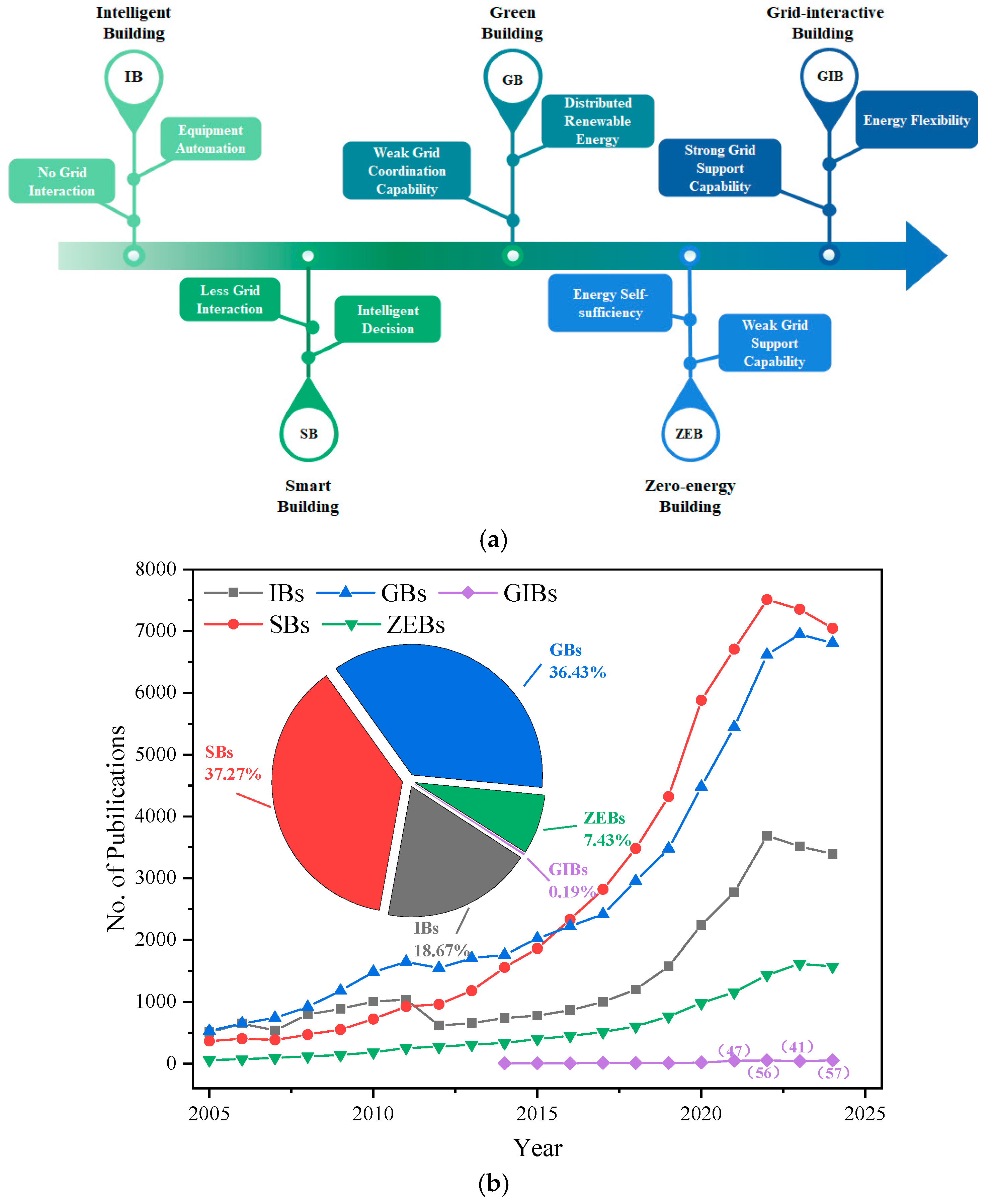
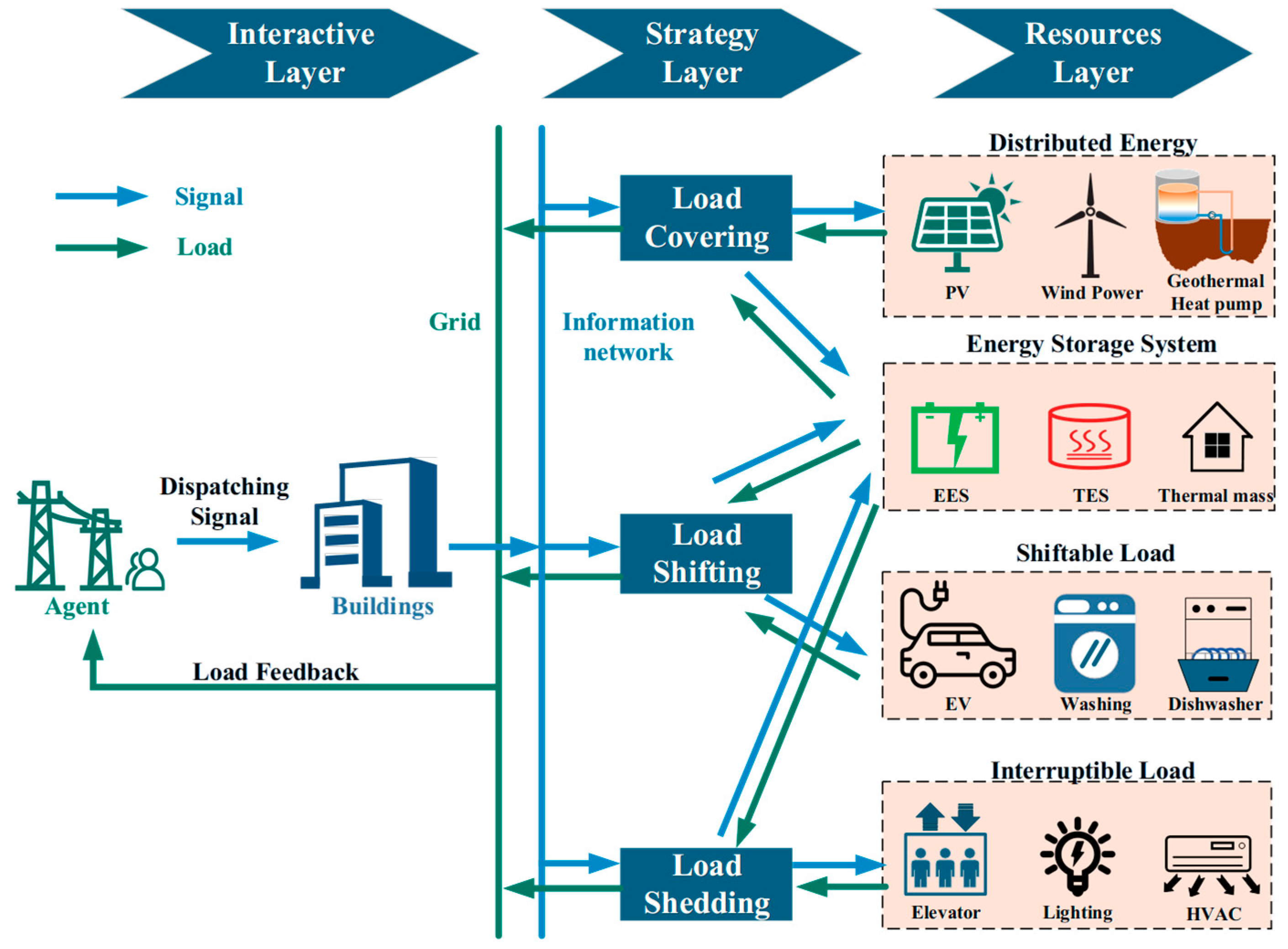

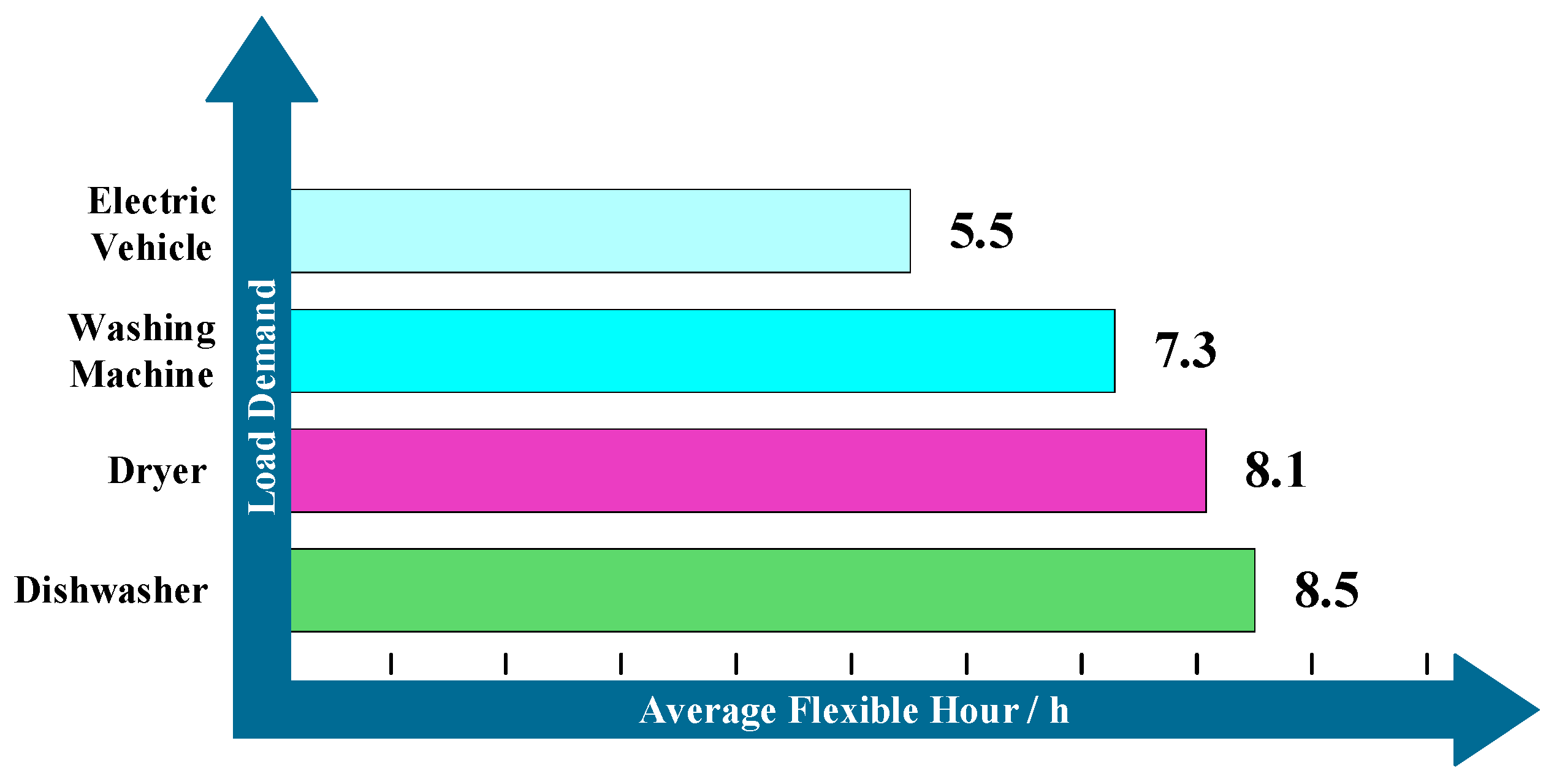

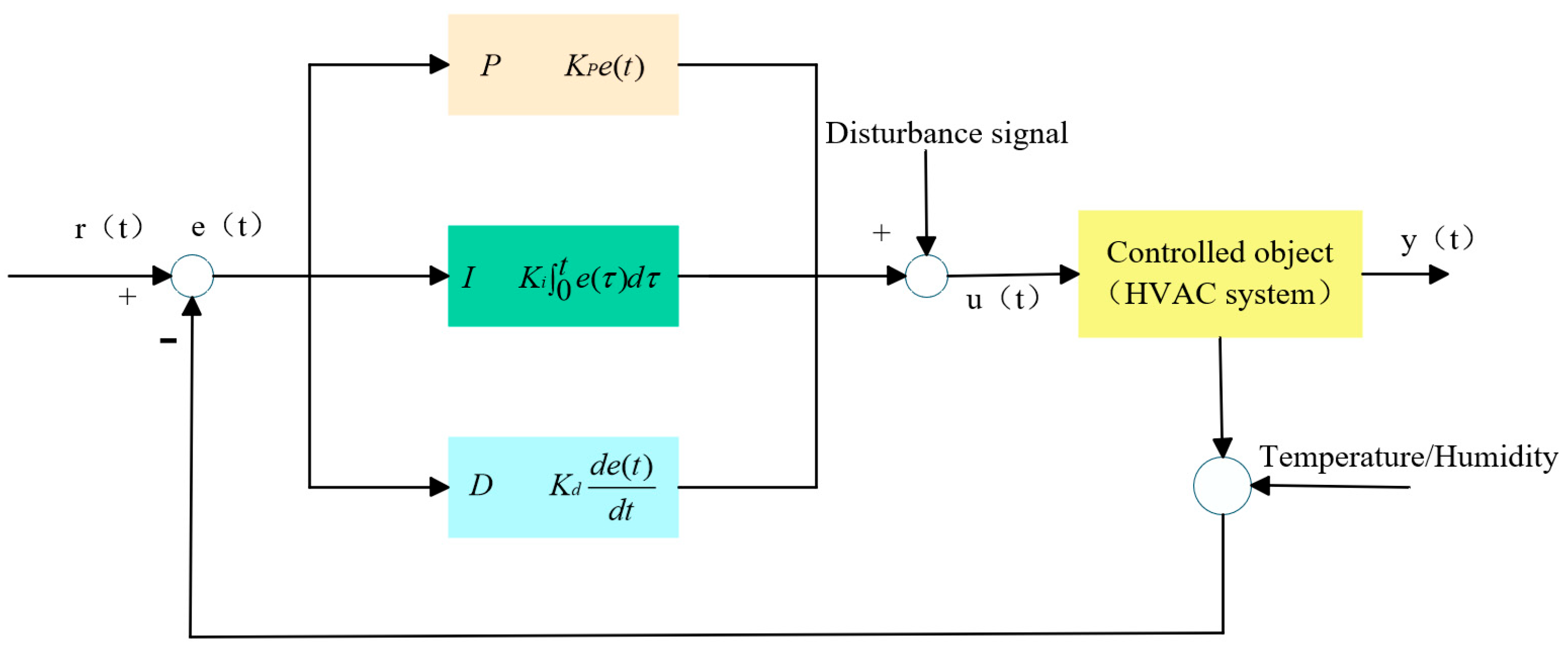
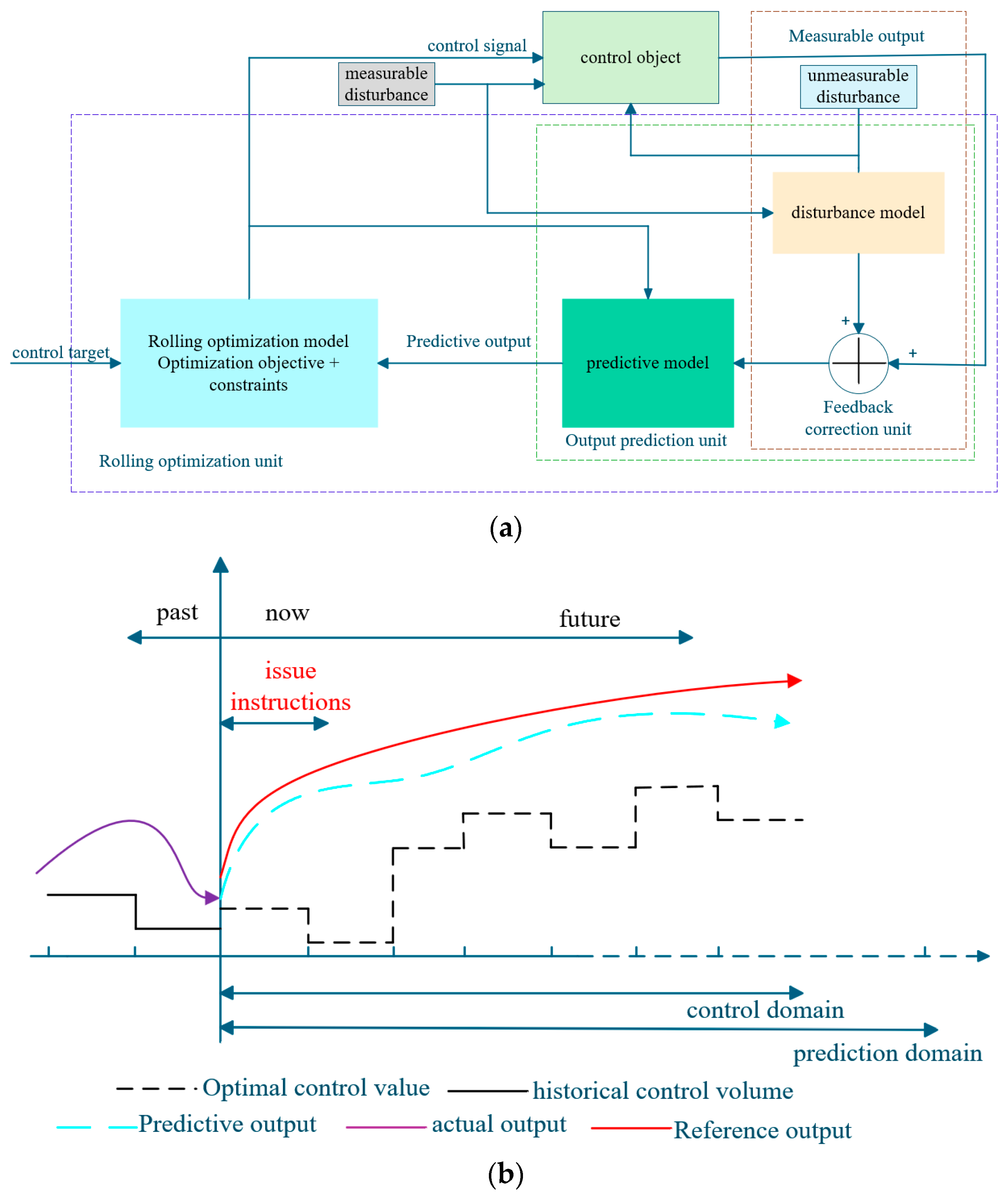

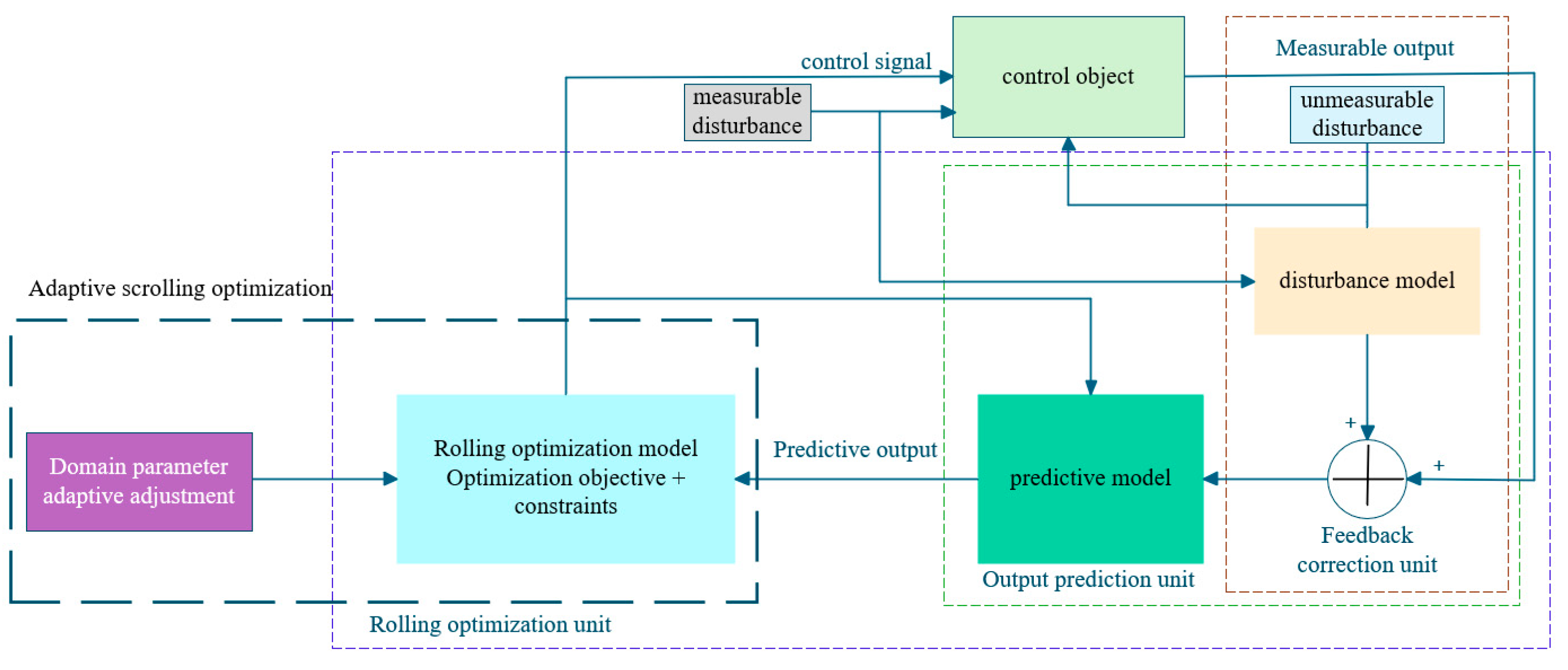
| BEM | Characteristics | Key Technologies | Grid Interaction |
|---|---|---|---|
| IBs [12] |
|
| No grid interaction |
| SBs [13] |
|
| Simple interaction with the grid |
| GBs [14] |
|
| Weak grid coordination capability |
| ZEBs [15] |
|
| Low dependence on the grid and weak grid support |
| GIBs [7,10] |
|
| Deep integration into the grid and strong grid support |
| Optimizing Scheduling Methods | Advantages | Drawbacks | Applications |
|---|---|---|---|
| Rule-based PID control |
|
| PID control can be applied to hot water tank management and HVAC systems, determining their behavior based on preset logic (such as schedules, weather conditions, etc.) to achieve more efficient energy management. |
| Model predictive control |
|
| MPC has a significant effect on climate control and cost–benefit analysis. |
| Multi-scale modelling predictive control |
|
| Multi-scale MPC not only meets building energy consumption management requirements but also achieves decarbonization goals. |
| Adaptive model predictive control |
|
| AMPC can be applied to heat pump-assisted solar hot water systems, which can effectively respond to grid fluctuations, provide flexible energy management, and optimize hot water supply through predictive control. |
| Data-driven predictive control |
|
| Data-driven predictive control enables accurate prediction of temperature, humidity, and energy consumption, improving energy efficiency and user comfort. |
| Agent-based Control |
|
| Agent-based control technology can balance energy efficiency and indoor comfort in buildings by dynamically adjusting equipment settings to reduce energy consumption. |
| EvaluationDimensions | Supported Key Performance Indicators | Define | Formula |
|---|---|---|---|
| Probability of grid-less interaction | Probability that a building or system will not interact with the grid within a certain period | PGNI: probability of no grid interaction; TNI: no grid interaction time; Ttotal: total system time. | |
| Independence | Mismatch compensation factor | Coefficient indicates the amount of compensation required by the mismatch between load and generation | Fmc: mismatch compensation factor (range 0–1); Pload,i: building area at the i-th moment Pres,i: renewable generation output at time i |
| Microgrid synergy | Evaluation of the response capacity of microgrid to the grid | Pnet,i: net ineractive power at time i; Pref,i: grid dispatch reference power at time i. | |
| Grid interactivity | Ratio of real-time net power interaction to the annual maximum interaction for a given time period | Rinst(t): real-time interactivity ratio at time t; Pnet(t): net interactive power at time t; : annual maximum net interactive power. | |
| Stability | Capacity factor | Ratio of average annual power interaction between the building and the grid to the nominal design capacity of the grid | Rannual: annual average interactive capacity ratio; Pnet,i: net exchange power at time i; Pgrid,nominal: grid nominal design capacity; N: annual number of time points. |
| Recovery rate | Ratio of peak switching to rated design capacity of the grid | ηrec: recovery rate; Ppeak: battery swap power during peak hours Pgrid: grid-rated design capacity. | |
| Total energy consumption | Total amount of all forms of energy consumed by buildings in a given period of time | EB: total building energy consumption; Db,s,t: energy consumption of a specific building type; TAb,s,t: activity level of a specific technology in buildings EIb,s,t: energy intensity of a specific technology in buildings. | |
| Efficiency | Peak power | Maximum electrical load reached by the building or system in a short period of time | Pmax: maximum value in the net load sequence; Pnet,i.: net load at time i. |
| Energy conservation | Percentage reduction in energy consumption compared to the baseline situation | Esr: energy saving rate; Ebase: baseline energy consumption Eactual: actual energy consumption. | |
| Flexibility | Demand response potential | Measurement of achieving aggressive renewable energy goals while maintaining grid reliability | DRP: aggregate demand response potential; : maximum upward dispatchable power; : minimum downward dispatchable power. |
| Energy storage utilization efficiency | Measurement of the efficiency of energy storage systems actually stored and released energy | hess: energy storage round-trip efficiency; Pch,i: charging power at time i; Pdis,i: discharging power at time i. | |
| Adjustment speed | Speed of system response to grid load changes | ui,j: ramp rate; PEi,j: end-of-interval output power; Psi,j: start-of-interval output power; TEi,j: end time; Tsi,j: start time. | |
| Storage capacity | Available storage capacity for storage technologies integrated into the smart grid | Cavail: average usable stored energy; Emax: energy storage system maximum capacity; Eres,i: reserved capacity at time interval i N: total time steps. | |
| Environmental Impact | carbon footprint | Refers to the emissions of greenhouse gases generated in a process | CF: carbon footprint; ADi: activity data for activity type i; EFi: emission factor for activity type i. |
| Renewable energy ratio | Percentage of renewable energy used in buildings | λ: renewable energy share of total energy consumption; Ei: annual renewable energy utilization; Eb: annual total operational energy consumption of building project. |
Disclaimer/Publisher’s Note: The statements, opinions and data contained in all publications are solely those of the individual author(s) and contributor(s) and not of MDPI and/or the editor(s). MDPI and/or the editor(s) disclaim responsibility for any injury to people or property resulting from any ideas, methods, instructions or products referred to in the content. |
© 2025 by the authors. Licensee MDPI, Basel, Switzerland. This article is an open access article distributed under the terms and conditions of the Creative Commons Attribution (CC BY) license (https://creativecommons.org/licenses/by/4.0/).
Share and Cite
Zhang, L.; Huo, M.; Zhou, T.; Pan, J.; Xu, Y. Energy Flexibility Realization in Grid-Interactive Buildings for Demand Response: State-of-the-Art Review on Strategies, Resources, Control, and KPIs. Energies 2025, 18, 4960. https://doi.org/10.3390/en18184960
Zhang L, Huo M, Zhou T, Pan J, Xu Y. Energy Flexibility Realization in Grid-Interactive Buildings for Demand Response: State-of-the-Art Review on Strategies, Resources, Control, and KPIs. Energies. 2025; 18(18):4960. https://doi.org/10.3390/en18184960
Chicago/Turabian StyleZhang, Long, Meng Huo, Teng Zhou, Jiapeng Pan, and Yin Xu. 2025. "Energy Flexibility Realization in Grid-Interactive Buildings for Demand Response: State-of-the-Art Review on Strategies, Resources, Control, and KPIs" Energies 18, no. 18: 4960. https://doi.org/10.3390/en18184960
APA StyleZhang, L., Huo, M., Zhou, T., Pan, J., & Xu, Y. (2025). Energy Flexibility Realization in Grid-Interactive Buildings for Demand Response: State-of-the-Art Review on Strategies, Resources, Control, and KPIs. Energies, 18(18), 4960. https://doi.org/10.3390/en18184960






